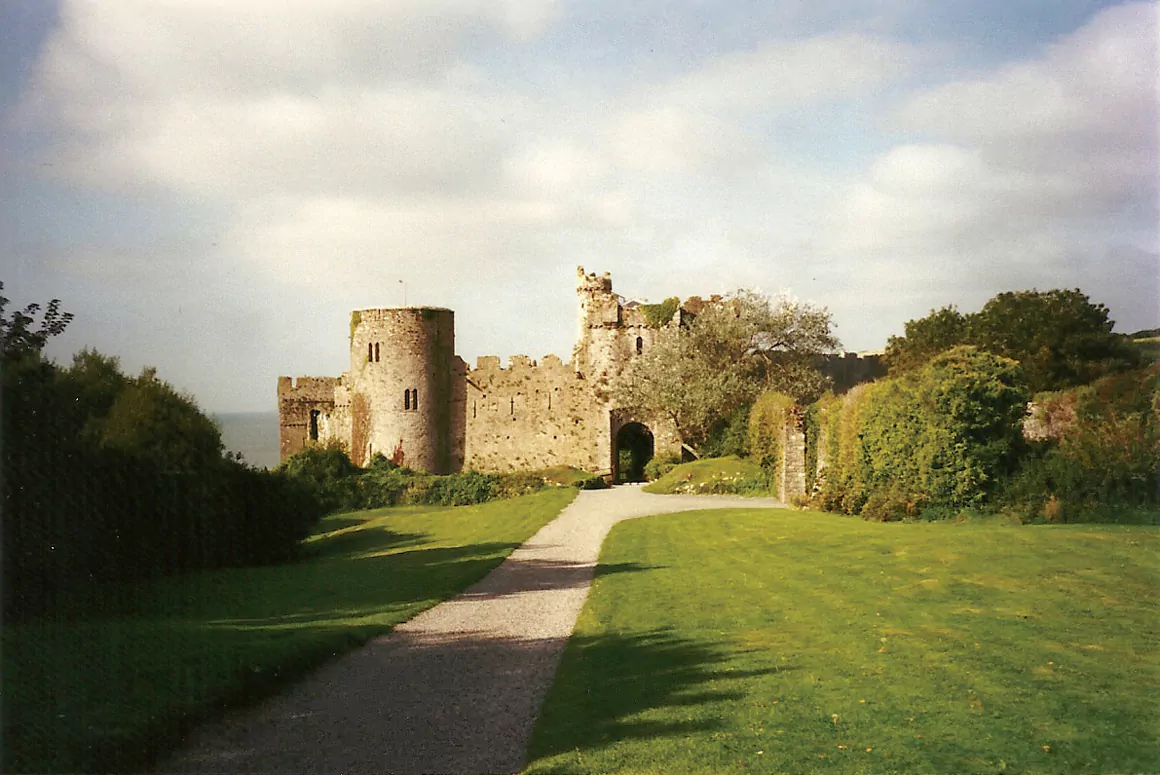Standing on Manorbier’s beach, looking at its 12th Century castle, I was aware I was following in the footsteps of an extraordinary Welshman.
The castle was the birthplace of Gerald de Barri, known as Giraldus Cambrensis, or “Gerald of Wales”, an amazing man for his time and someone lauded as Wales’s ‘first travel writer’.
I was staying in a cottage about 1½ miles distant, at Manorbier Newton, but it was the seaside village of Manorbier, the “Manor of Pyr”, where thoughts turned to a Welsh cleric of the late 12th and early 13th Centuries.
Manorbier is a village about 5½ miles from Tenby, its most memorable landmark its castle, affording spectacular views over beach and sea. Gerald loved it here. More modern figures agreed, for George Bernard Shaw and Virginia Woolf visited. Woolf decided to become a writer, aged 21, walking along the seashore. War poet Siegfried Sassoon wrote “A Ruined Castle” here in 1924.
Gerald was engaged on serious business. The Welsh monk and scholar was travelling in the company of Baldwin, Archbishop of Canterbury, garnering recruits for the Third Crusade. It was this journey in 1188 that Gerald recorded in “The Journey through Wales” and “The Description of Wales”.
During an eventful life Gerald tutored Richard I (“Lionheart”) and King John, also acting as rector of several Welsh churches, for example, Brecon and Tenby. Gerald showed political inclinations, campaigning unsuccessfully to have St David’s recognised as a bishopric independent of the English church.
Gerald was born in about 1146 in Manorbier’s castle, of mixed Welsh and Norman ancestry. One of Gerald’s earliest memories was of a Welsh raid, when he begged to be taken to the sanctuary of the village church, showing early on a proclivity for things spiritual. His father nicknamed him “my bishop”.

Giraldus Cambrensis or “Gerald of Wales”
Gerald was proud of his birthright, of his Welsh blood and being a “Marcher”, someone inheriting Welsh courage and Norman skill in warfare. Gerald’s ancestry would prove a mixed blessing. He was in demand when an English King required a diplomat to negotiate with Welsh and Norman, but could be overlooked for promotion because of his Welsh antecedents. Twice Gerald saw his selection as Bishop of St David’s fail to be ratified.
To stand on the beach here is evocative, for this was Gerald’s playground as a boy. Walking where he played and staring up at his birthplace, we felt close to the man, as though 800 years were bridged.
The vista has not changed much. The castle sits on its hill, overlooking beach and approach from the sea. There are a few houses and also the inevitable car park, but it is a scene Gerald would recognise. The castle is accessed up a drive, over a wooden bridge, through gardens, to its main gateway. The walk must have been familiar to Gerald, with sea visible over hedgerows. Although much of the present building was constructed later, there is a small tower by the gate, together with a hall, which Gerald probably knew and explored.

Manorbier Castle
Today the castle is a tourist attraction, with great hall, walled gardens, gift shop and café. There is a cottage, situated within the castle walls, offering guests the freedom of the grounds. The old vaulted chapel is available for weddings. Fortunately the castle suffered only minor assaults, including one during the English Civil War, when Parliamentarians seized it.
Gerald’s childhood was a happy one. Later in life he praised Manorbier. He played with his three older brothers. Is it too fanciful imagining them building sandcastles on the beach in imitation of their home, which they could use as a template? As Gerald grew, it was churches rather than castles interesting him, for as the youngest of four, he was unlikely to inherit the estate. At the age of nine or ten, it was no surprise Gerald left to continue his education at Gloucester Abbey.
On the recruitment drive of 1188 Gerald returned to Manorbier and described what he saw. Between castle and church (St James) he described a stream. Today fossils are found in the streambed, as the water disgorges into the bay. Gerald thought the region around Pembroke the pleasantest in Wales, with Manorbier its jewel.
When Gerald died at St David’s, in his mid to late 70s, he had completed a full and eventful life. As well as a cleric (eventually Archdeacon of St David’s) and royal chaplain, he was an historian and travel writer (including myths and legends, natural history and people). He spent time in Paris and Ireland. The journey through Wales is what Gerald is most remembered for, however, a round trip beginning and ending in Hereford, around virtually the whole Welsh coast in a clockwise direction.
We were delighted to visit a beautiful part of Wales, but also to follow in the footsteps of one of its most famous sons. Gerald was a remarkable man, someone who would have been considered a “Renaissance” figure in later times. As someone who likes exploring my homeland, then writing about it, I hope I do justice to the tradition started by “Wales’s first travel writer”.
Words: Stephen Roberts
Feature image: Martin Talbot – flickr.com/photos/tigr/80925773/, CC BY 2.0, Source
Giraldus Cambrensis or “Gerald of Wales”: Wolfgang Sauber, CC BY-SA 3.0, Source
Manorbier Castle: © Stephen Roberts





